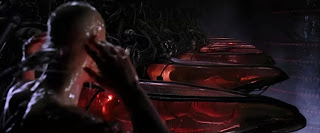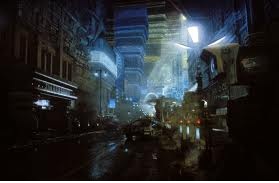The story takes place in the future where
humans live in a simulated reality
created by a programme called the Matrix and are unknowingly being harvested by
machines to substitute the Sun as power supply. Thomas A. Anderson, a hacker known as
Neo was told by the leader of underground freedom fighter, Morpheus that he is “the
One” who will save the human race against the machines. Neo embarks on a
journey to discover the truths about the world, both synthetic and real, and
his extraordinary abilities. Along with Trinity and Morpheus, he fights against
the enslavement of humanity.
The German Expressionist theme of self-analysis
is apparent in Neo’s struggle to seek the truth about the Matrix and himself. Neo
is given a choice to choose between the red and blue pills when he is offered
the option to either go back to his life or (Figure 6.01) to explore the truths
about the world he doubts of. Neo questions himself if he is truly ‘the One’
who has the capability to change the world when he is told by Morpheus of the
Oracle’s prophecy. He experiments with his ability by jumping to the opposite
building in his training session. When Morpheus says “something’s wrong with
the world, you don’t know what, but it’s there”, Neo ponders deeply about the
world he used to live in. This line later evokes Neo’s determination to uncover
his true self. In his first trial to enter the real world, he looks into a
broken mirror and sees his own split image (figure 6.02) which reminds him of
his dual identity as both Neo and Thomas A. Anderson. Neo then starts to
convince himself of his strength when he fights Agent Smith. He makes up his
mind to go back and save Morpheus as “the One”.

Figure 6.01 Neo making a choice between
to fight or to not fight
Figure 6.02 Neo looking into the mirror
Revolt is seen in the crew members of
Nebuchadnezzar and their rebellion against the machines. They “unplug” others
from the Matrix to free and recruit them to join the fight against enslavement.
They defy the authority by manipulating the physical law in the Matrix to
obtain superhuman powers. Neo, upon discovery of the truth and his abilities
chooses to fight against the machines and save the human race. When Neo and Trinity go back
to the Matrix to save Morpheus, they encounter Agent Smith and fight him
instead of running away. Neo punches the agent, smashing into his glasses
(figure 6.03). He revives from death and gains power to defeat Agent
Smith (figure 6.04 and figure 6.05).
Figure
6.03 Agent Smith and his broken shades
Figure
6.04 Neo stops the bullets in mid-air
Figure
6.05 Agent Smith’s shell exploding
Primitive, sexual
savagery can be found in the scene where Neo first enters the real world. He wakes
up in an embryonic pod with his body hairless and nude like a new-born baby
(figure 6.06). He looks down and sees many other foetus. The primal instinct of
human is also depicted in the belief in the Oracle’s prophecy of “the One” as
it is human nature to rely on the existence of God or deities when facing
difficulties in life.
The theme of
madness is significant throughout the film. The story sets in a surreal world
of madness where the Matrix constructs a synthetic world (dream world) for
humans to live without noticing. Artificial Intelligence which is human-made
becomes conscious and turns destructive, consuming mankind to power itself. The
machines are crazed and out of control, leaving humans defenceless against
their rule. In order to keep themselves powered, the machines resort to turn
their backs at their own creator and harvest lives. Human species becomes lives
planted in a massive power plant and artificially grown in an embryonic pod
like test-tube babies. The roles of the experimenter and experimented are
exchanged.
Figure
6.06 Neo emerges from an embryonic pod
Figure
6.07 Neo discovering other foetus in the embryonic pods
In the film, oblique
camera angles are extensively used to portray the distortion of the reality in
which the characters are living in. Bird-eye view shots are frequently used in
the film to show the height of the location and the design of the buildings on
set. Bird-eye view is used to show the environment of a set. In the beginning
of the film, bird eye view was used to show the pulse-like surface of the building
(Figure 6.08) which suggests the pulse of the character (Trinity) pumping fast
in a chase scene. The same angle is used when Trinity makes a leap to another
building far away to show the distance between two buildings as well as to
break the built up pulse pattern in the earlier scene.
Figure
6.08 Bird eye view to show the pulsing surface of the building
Figure
6.09 Bird eye view to show Trinity jumping from one building to another
The bird-eye view in
showing Neo’s room shows how messy it is (Figure 6.10) and works as a stark
contrast to his neat cubicle in his office(Figure 6.11) to illustrate his
double life.
Figure
6.10 Neo’s Messy room
Figure
6.11 Anderson’s neat cubicle
Bird-eye view angle is
also used to enhance the grim look of an establishment (as shown in Figure 6.12),
when Neo is brought to Morpheus’ place, he slowly unravels the mystery and
confusion he has in mind as indicated by the rotating bird-eye view as he walks
up the stairs (Figure 6.13). In another instance when Morpheus is being
surrounded, the bird-eye view enhances the helplessness and the trapped state
(Figure 6.14).
Figure 6.12 Neo is brought to Morpheus
Figure 6.13 Neo walking up the stairs
Figure 6.14 Morpheus surrounded by the police
When Neo is under Agent
Smith’s custody, the scene takes the angle from the security camera to depict
how Neo is placed under observation. A fish eye lens is used to show
distortion, much as though under a microscope to show Neo’s uneasiness(Figure
6.15).
Figure
6.15 Neo under the agent’s custody
Another German
Expressionist visual characteristic is the distortion of shapes and bodies. In
the entire film, straight and slanted lines are presented in almost every shot.
The lines indicate order, control and the fact that the people are imprisoned
behind the lines (bars) in a system.
Figure 6.16 The early chase scene in the film, straight lines
are never absent in each scene, representing the order of the world and bars
that imprison the character
Aside
from the straight lines that represent order and control, the distortion of
physical appearance is evident in the agents’ uniform movement and attire that
give the rigid feel and are self-explanatory to the agents’ identity as
machines functioning to regulate the irregular (Figure 6.17).
Figure
6.17 Agents walks uniformly in Neo’s office and the same stern look on their
face
The
use of distorted reflection is used to suggest a distorted reality as well as
self-analysis. When Neo takes his red pill from Morpheus, he looks into a
broken mirror and sees a double image of his own. The cracks on the mirror then
disappears as the mirror restores (Figure 6.18) The double image Neo sees
represents his double life as a hacker and as an employee in a big corporation
while the restored mirror, now only reflecting “Neo” hints on the end of his
life as Anderson.
Figure
6.18 Neo looks into his reflection in the mirror
The use of distorted
reflection when Neo is about to open the door of the Oracle’s place indicates
his psychological state of anxiety in unraveling his fate and the anticipation
of something life-changing (Figure 6.19).
Figure
6.19 Neo about to open the door knob of Oracle’s house
Hallways in the film
are elongated and appear squarish, resembling a jail or a box (Figure 6.20).
The scene where Neo spars with Morpheus gives a cage-like feel with the lines
and squares surrounding the characters (Figure 6.21). Another distortion that
appears at least three times in the film is the rotating bird-eye view of the
staircase in Morpheus’ hideout (Figure 6.22). The checkered pattern on the
floor suggests repetition and order, along with the rotating camera movement
and the staircase, the distortion gives a feeling as though the order is
breaking down as the story unveils and everything is drawn into a state of
madness.
Figure
6.20 Morpheus guiding Neo to the Oracle’s house
Figure 6.21 Morpheus spars with Neo in the training program
Figure
6.22 The staircase shot in Morpheus’ hideout
The Matrix takes a
gothic setting as seen in Morpheus’s hideout (Figure 6.23) and the characters’
monotonous and dark costumes (Figure 6.24).
Figure
6.23 the interior of Morpheus’ hideout
Figure
6.24 Character design and costumes in the Matrix
The real world in which
the humans live comes with a bizarre steam punk architecture. Unlike in the
Matrix, the real world is packed with metal elements, with wires and sometimes
electrical surges to bring to live a hellish world of devastation (Figure 6.25
and Figure 6.26).
Figure
6.25 Steam punk elements in the real world
Figure
6.26 Steam punk rail gun
Chiaroscuro lighting is
applied throughout the film to suggest the darkness that prevails in the story
world. Especially in the earlier scenes of the film, the high contrast lighting
is heavily used to hint that something mysterious and malicious is going on.
Figure 6.27 shows a series of usage of such hard lighting to evoke a sense of fear
and insecurity.
Figure
6.27 Examples of high contrast lighting
















































